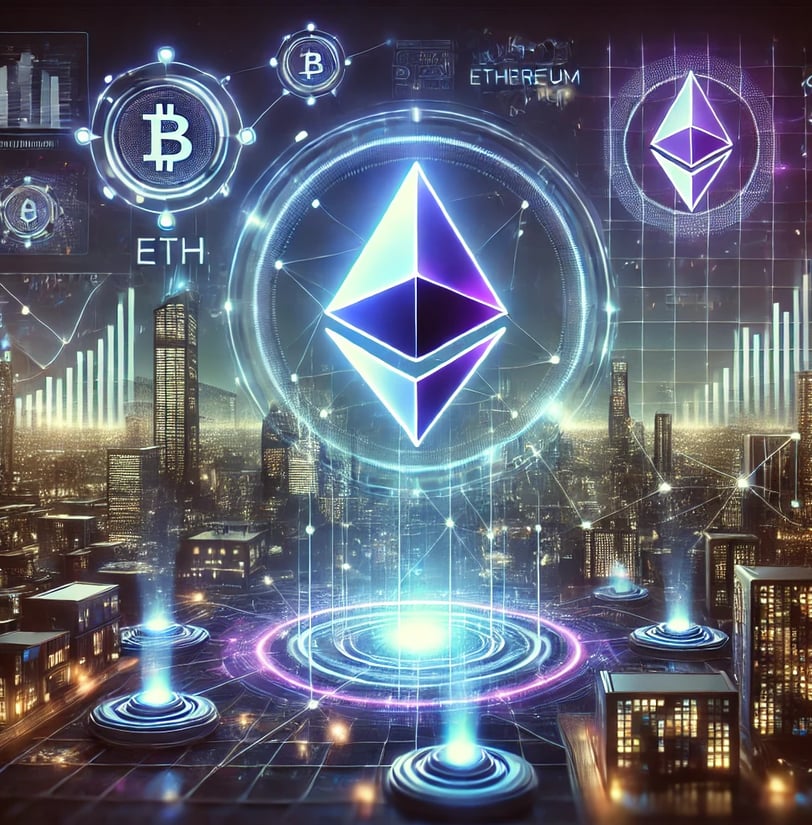Ethereum (ETH): A Complete Analysis of the World's Second Largest Cryptocurrency
CRYPTO MARKET
1/30/20252 min read


Since the emergence of Bitcoin, the world of cryptocurrencies has undergone a constant revolution. Among the various existing digital assets, Ethereum (ETH) has stood out as one of the most innovative and promising. In this article, we will discuss the history of Ethereum, its main characteristics, use cases, impact on the financial sector, its appreciation over the years, and projections for the next bull cycles.
The Emergence of Ethereum
Ethereum was proposed in 2013 by Vitalik Buterin, a Russian-Canadian programmer, who noticed Bitcoin's limitations regarding the execution of smart contracts. The project was officially launched on July 30, 2015, after a successful crowdfunding campaign (ICO) that raised around $18 million.
The central proposal of Ethereum was to create a decentralized platform that allowed the execution of smart contracts and the development of decentralized applications (dApps), significantly expanding the possibilities of blockchain technology.
Ethereum Token Supply
Unlike Bitcoin, which has a maximum supply of 21 million coins, Ethereum initially did not have a defined issuance limit. However, with Ethereum's transition to the Proof of Stake (PoS) model through Ethereum 2.0, ETH issuance was reduced. Additionally, with the implementation of Ethereum Improvement Proposal (EIP-1559), part of the transaction fees began to be burned, reducing the asset's inflation.
Smart Contracts and Decentralized Applications (dApps)
One of the greatest innovations brought by Ethereum was the introduction of smart contracts, which are self-executing codes stored on the blockchain. These contracts allow various applications to be developed without intermediaries, ensuring security and transparency.
Decentralized applications (dApps) have driven sectors such as blockchain gaming, digital identities, decentralized marketplaces, and decentralized financial services.
Ethereum's Role in DeFi (Decentralized Finance)
Ethereum plays a fundamental role in the decentralized finance (DeFi) ecosystem. DeFi protocols such as Uniswap, Aave, and MakerDAO allow users to take out loans, provide liquidity, and exchange assets in a decentralized manner.
By eliminating traditional intermediaries, financial services become more accessible and efficient. This trend has attracted institutional investors and individuals seeking greater autonomy over their resources.
Ethereum's Appreciation Over the Years
Ethereum's price has gone through significant appreciation cycles since its launch. During the ICO, ETH was sold for about $0.30. In 2017, driven by the ICO boom and growing institutional interest, the price reached approximately $1,400, followed by a major correction in 2018.
In 2021, Ethereum recorded new all-time highs, surpassing $4,800, driven by the rise of DeFi and NFTs. However, like any volatile asset, Ethereum has also undergone corrections over time.
Price Projections for the Next Bull Cycles
Predicting Ethereum's future price is a challenge, as it depends on factors such as institutional adoption, government regulations, technological innovations, and macroeconomic scenarios.
Some analysts suggest that in the next bull cycle, Ethereum could reach values between $8,000 and $15,000, especially with the increasing adoption of scalability solutions and blockchain advancements.
Ethereum has established itself as one of the leading cryptocurrencies in the market, revolutionizing various sectors through its technology. Its role in DeFi, NFTs, and innovations such as smart contracts reinforce its relevance in the crypto ecosystem.
However, it is essential to emphasize that the cryptocurrency market is highly volatile and speculative. Therefore, any investment decision should be made with caution and based on thorough research.
Disclaimer: This article is not an investment recommendation. The cryptocurrency market is volatile, and investments should be made based on individual analysis and advice from specialized professionals.
